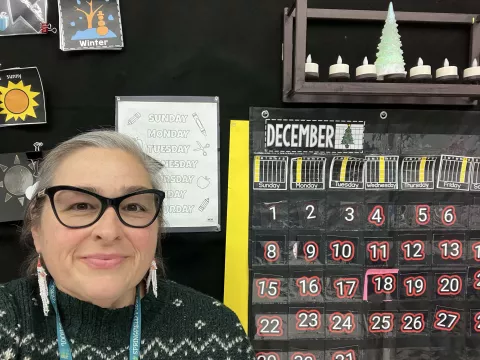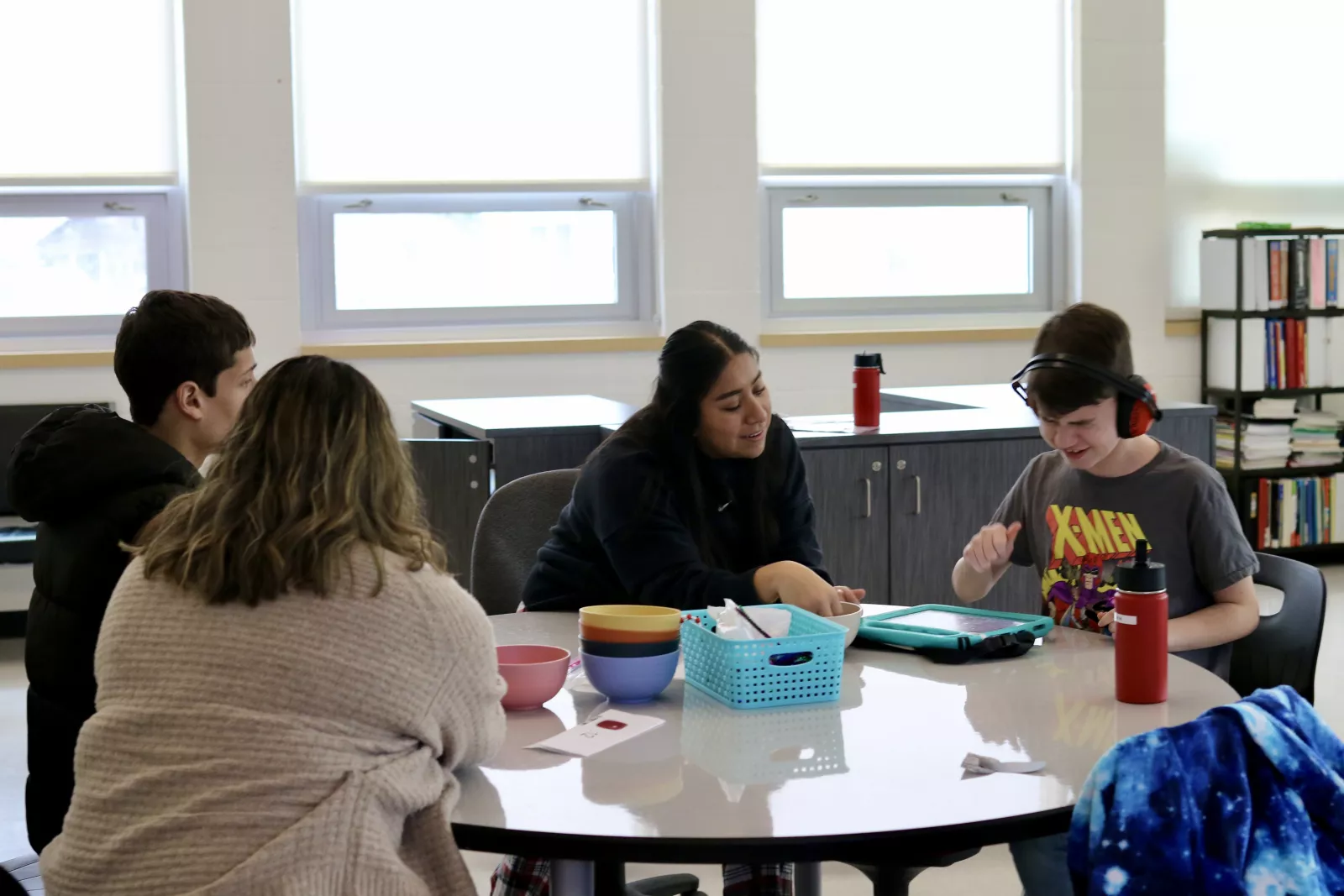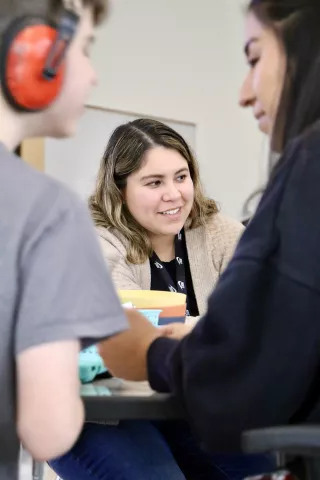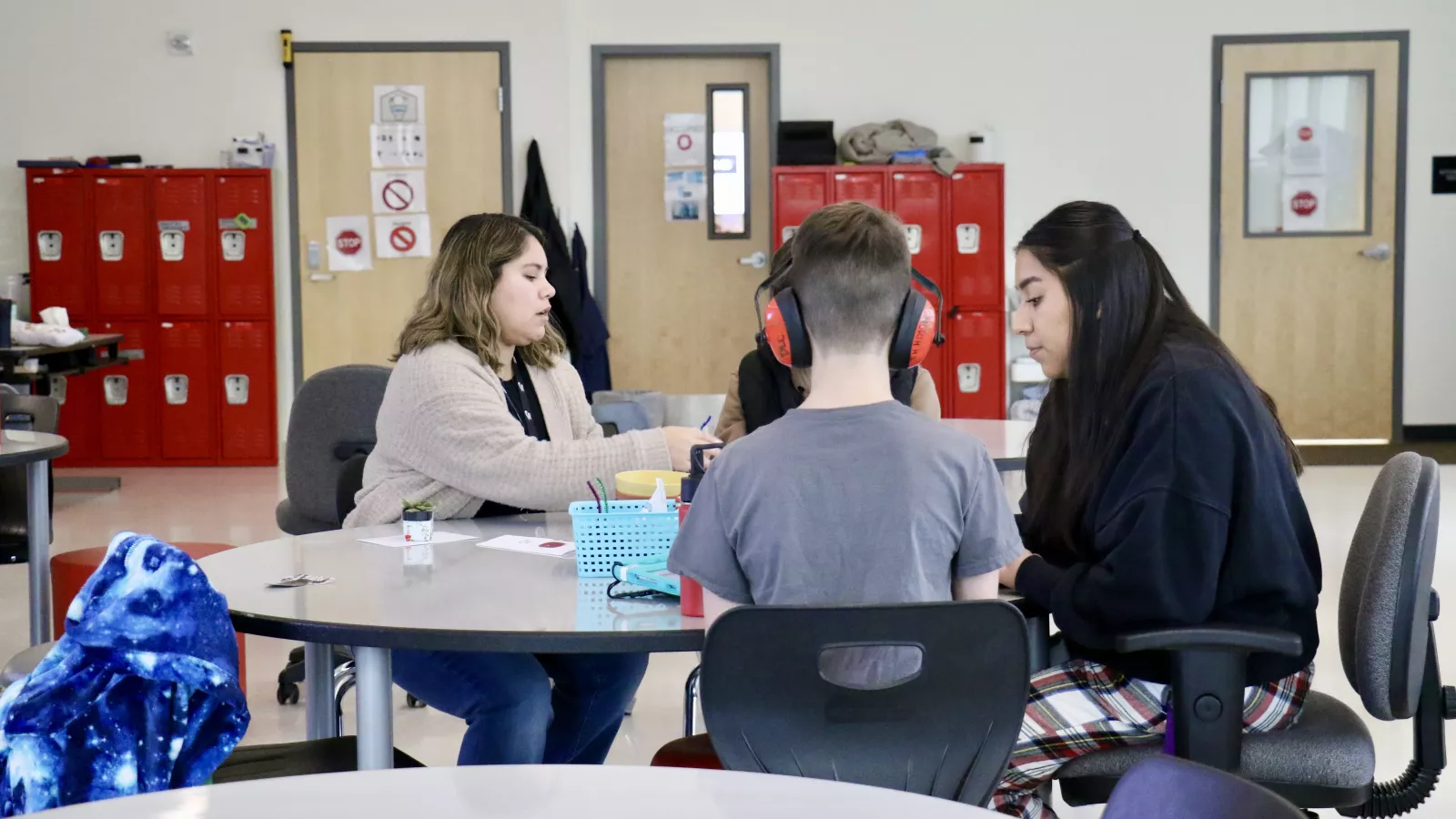Venus Reeve came to Oregon to get her master’s in Special Education at the University of Oregon, and has been teaching Special Education (SPED) in Springfield and Eugene for the past 20 years. She’s honed her craft and is one of Special Education’s biggest proponents, currently serving as Chair of OEA’s Special Education Committee. “Special Education just appealed to me. I have always had a passion for fighting for the underdog, and making sure that everyone has equal access.”
Reeve cares deeply about serving SPED students in the least restrictive environment possible - but the reality of understaffing and underfunding makes her work insurmountable at times. “We are required to include SPED students in Gen Ed classrooms as much as possible - but we don't have enough staffing, so oftentimes kids just get dropped into classrooms of 28 kids, when really they can’t function with that much stimulus, and certainly not without an adult helping them one-on-one. And while that seems like the “least restrictive” environment, it actually isn’t for them,” she reflects.
Special Education in Oregon is in crisis. Because funding levels are currently capped at a number of students far below actual enrollment, our classrooms are suffering from unsafe staffing levels, insufficient support for students, and the loss of experienced SPED teachers, which only compounds the problem. The "SPED cap," which clearly does not reflect districts’ actual need, has led to a gap of between $350-$400 million per biennium in SPED funding.

The Oregon Education Association estimates that special education in Oregon is underfunded to the tune of over $700 million per biennium. But to understand the problem, it’s helpful to know how the state funds special education in the first place.
Districts are funded based on their total number of enrolled students, with each additional student translating to one additional “weight,” or per-student dollar allocation.
Under the federal Individuals with Disabilities Education Act (IDEA), students who qualify for special education services are entitled to “inclusion,” meaning that they be integrated to the greatest degree possible into schools and, where possible, into general education classes, with individualized supports designed to allow them to function and learn in the least restrictive environment possible. These can include anything from specialized academic instruction to behavioral and medical support.
The impacts are felt on both sides of the spectrum. “We have Gen Ed students, who are just trying to get an education in a safe space, having their rooms cleared regularly and parents asking, ‘why is that kid still allowed to be in my child’s classroom if he's going to throw a chair every day?’ And it’s because we don't have any other options. So now other students are traumatized, about the chair throwing kid, and their sense that the staff cannot keep them safe. It creates enmity between our families and the school, between gen-ed and SPED students. And that “us vs. them” dynamic is not serving anyone,” Reeve says.
In 2023, OEA provided feedback on Senate Bill 819, which mandated that SPED students must be provided with the same number of in-school instructional hours as their general ed peers.
To meet the additional expenses of SB 819, districts currently receive the equivalent of one additional “weight,” or per-pupil allocation, for every special education student. There are two problems with that allocation. The first is that some interventions, such as one-on-one support personnel, can cost districts far more than double what a gen-ed student costs. This accounts for perhaps $160 million of the shortfall.
The second, and somewhat larger issue, is that while 14.8 percent of all Oregon students qualify for special education services, state law currently caps district weights for SPED at 11 percent of overall enrollment. The results are that special education programs are broadly understaffed, and there is a troubling disincentive for districts to acknowledge and provide the levels of support necessary for individual students to thrive, or even ensure the safety of students and staff.

Alejandra Saechao has been working in special education for eleven years, and is currently a SPED case manager in the Salem-Keizer School District. Saechao currently manages a high school developmental learning classroom with 24 students who are at the highest level of need.

“My class has three students that need one-on-one [support] due to medical needs. And I have behavior needs that require one-on-one. Then, I have one student that needs two-on-one. So when all the students are here, those four students alone take up half of our staff. Today, we're down three instructional aides. I would say 80 percent of the time I don’t get a prep or a lunch because I'm having to fill in for staff or having to jump in and support behavior issues, because our job is to keep students safe. We have five students who use feeding tubes. Eight others have feeding protocols that we need to monitor for pacing, for size of food, to prevent choking. So we can't just have one person sit with five of them.”
The lack of resources means that the administration is often incentivized to place even further burdens on the educators who have to deal with these issues directly, potentially making everyone less safe.
Saechao is often faced with an impossible dilemma: “At what point is a student so unsafe that I write them up or send them home? We need to know what the threshold is, and no one can give us an answer. Yesterday, we were dealing with a very dysregulated student who was escalating for two hours, and I was exhausted, and we were asked to give it another 30 minutes before that call was made. Campus security was there with us, and they’re exhausted too. But I can’t make that call.”
In Saechao’s experience, these situations, combined with inadequate staffing levels, regularly negatively impact the entire class.
“You need to decide, ‘do I focus on my two high behavior needs students? If all of my effort and resources are going to these two students, how am I supporting the other 22, because they're just getting by as it is.’”
Malory Turner began her career as a special education instructional assistant at an elementary school, during which time she got her Masters in Special Ed. After getting her license, she worked as a resource teacher at the middle school level. Now she is a Special Education Professional Learning Coach at Northwest Regional Education Service District.
“I support training special education teachers, case managers, directors. The series that I'm doing this year is focused on IEP writing,” she says.
Turner knows firsthand the tremendous demands, both in and out of the classroom, that are being placed on SPED educators, and the toll it is taking on them and on the system.
“They're drowning in the paperwork. The IEP itself is a lot. That IEP is multiple pages long, and if it's done right, it's full of meaningful and important data that takes a lot of time and effort to piece together, and you're usually collaborating with multiple folks to put that whole plan together. And if you have 45 kids, you're doing that 45 times. Then you have re-evaluation paperwork in between all of the required meetings. Then there are more legal documents to say that the meetings are coming, and again to say that the meeting happened, plus any changes that you make to the document. So the paperwork just starts to stack up and then you start to fold in these other pieces that come in, like an abbreviated school day. That’s more paperwork and more meetings and more follow up.”
Combined with the daily stresses of trying to educate a classroom of high-needs students — the inevitable disruptions, medical, behavioral, and academic needs, while being perpetually understaffed - good, experienced SPED educators are being driven from the profession. Districts are forced to bring in less experienced educators with little to no SPED training, compounding the problem.
“These things are really overwhelming,” says Turner. “Even the most experienced special educator can feel overwhelmed, from the students, the classroom, the paperwork. But now if you put someone in there on an emergency license, and they haven't gone to school for special education, and maybe they've never even worked in a school before, now they're the licensed educator. And they have to navigate how to do the legal paperwork, plus navigate how to be a teacher. And a lot of the teachers I see now are on emergency licenses, because the positions are hard to fill. People are leaving the field. Good educators that had all this experience are leaving.”
Venus Reeve, the 20-year veteran SPED teacher from of Springfield and Eugene, is committed to providing the best education possible for her students, but is also deeply frustrated at the disconnect between the vision of inclusive education and the lack of adequate funding to make it work.
Reeve, who is currently teaching a class of 24 high-needs student, is a strong supporter of inclusion, but she has trouble reconciling the requirements with the lack of resources. She is a supporter of Senate Bill 819, which passed in 2023 and introduced significant changes to the operation of abbreviated school day programs in order to ensure access to education for all students.
“Yes, every child deserves a full school day, in a classroom, and every parent must have access to this for their child. But we haven't provided adequate funding for trained staff, or to set up spaces that allow children meaningful access to that education. [I’m angry] because I know we can do this. We have done this in the past. We know how to do this. All we need is the funding. I don't even have appropriate space to educate my children, where I can provide them the support they need. The classrooms that we have are loud and busy and filled with students who are not getting their needs met. And so we have teachers and support staff who are stressed, but we're asking them to be cool, and calm, and deliver all the instruction, while dealing with children who are also stressed to the limit because they aren't getting what they need.”
Many students, for example, need continuous one on one medical or behavioral staff support, and nearly every student needs additional academic support, combined with voluminous paperwork that must be continuously updated. The result is that special education is far more resource intensive, and thus far more expensive than general ed.
Matt Bell, President of the West-Linn Wilsonville Education Association, believes the inclusion model works well when it's staffed correctly and is prioritized by district leadership.
“The lDEA model of inclusion is basically that all students should be able to be in school, and included in the general education classroom as much as they personally can be. It's something that our teachers, Special Ed and General Ed alike, believe in. It's something that our district leaders believe in. Here in Wilsonville, we have district leaders who have written books about inclusion. We’ve been highlighted in national stories about it. We’ve had people move here from across the country, and yet we don't have the resources from the state to do the model the way it's intended to be done.”
Quote byMatt Bell , President, West Linn-Wilsonville EA

Looking Ahead for Answers
Over the last year, OEA members and leaders have diligently laid a foundation for finding revenue solutions to the SPED funding crises. Part of this work involved convening a Special Education coalition of labor members, parents and policy-makers to explore what it would look like to raise the cap on Special Education funding during the 2024 short legislative session. OEA members also worked to secure some fixes in the 2024 session to the most problematic parts of SB 819 (Abbreviated Day) bill.
In the 2025 long legislative session, OEA plans to build on the work started in the 2024 session and fight to raise the 11 percent cap to reflect the actual numbers of SPED students enrolled in Oregon schools. That alone would alleviate around half of the estimated funding shortfall.
When SPED students are integrated into an inclusion model and receive adequate levels of care and connection, the entire school community is enriched. But in Oregon, public education funding has not kept up with the needs of SPED students. This shortfall keeps educators from providing the resources students need to thrive in a fully inclusive schooling model. According to OEA’s research, the cap stands at 11 percent of total enrollment, but nearly 15 percent of Oregon students are in SPED programs. In a district like Salem, that number is around 17 percent , and in Lebanon it inches toward 22 percent.
In a more functional political environment, federal funds that have been previously earmarked to support special ed would cover some of this, but that hasn’t happened in the past, and is unlikely to change.
“Currently, the federal government only funds around 17 percent of what they had promised.” says Louis DeSitter, one of OEA’s Government Relations consultants. “That’s clearly central to the problem, and we don’t realistically see that number increasing in the near future. So it falls to the state. And if the state doesn’t step up, it all falls on our educators and our students and their families, which is where we’re at now. And that’s causing us to lose experienced educators, which of course makes the problem worse and even harder to deal with, which leaves more students behind, or unsafe, or unsupported, which then makes hiring more difficult, even for the positions that are funded. It’s become something of a death spiral, and it needs to be addressed.”
